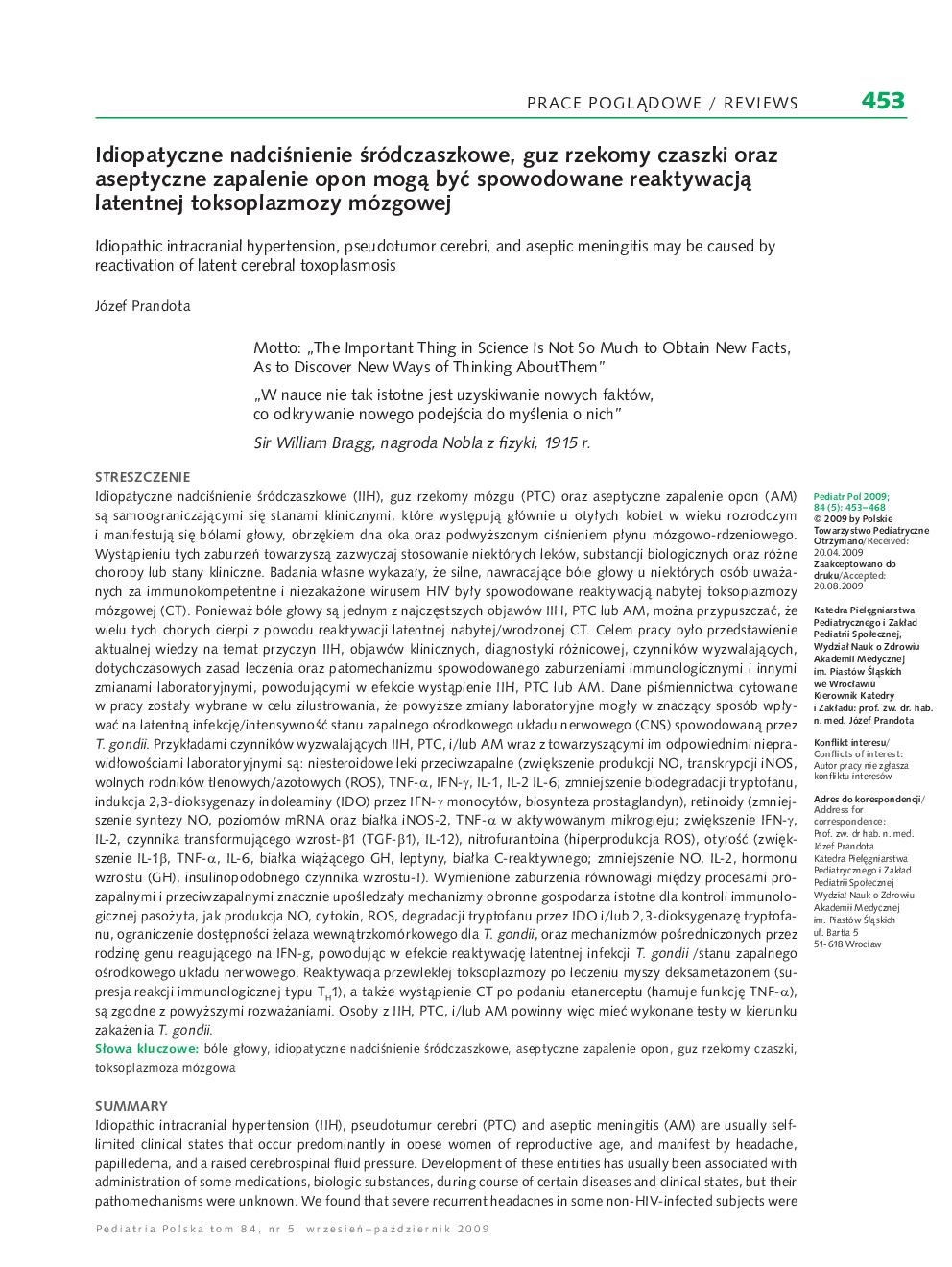| کد مقاله | کد نشریه | سال انتشار | مقاله انگلیسی | نسخه تمام متن |
|---|---|---|---|---|
| 2680146 | 1142320 | 2009 | 16 صفحه PDF | دانلود رایگان |
عنوان انگلیسی مقاله ISI
Idiopatyczne nadciÅnienie Åródczaszkowe, guz rzekomy czaszki oraz aseptyczne zapalenie opon mogÄ
byÄ spowodowane reaktywacjÄ
latentnej toksoplazmozy mózgowej
دانلود مقاله + سفارش ترجمه
دانلود مقاله ISI انگلیسی
رایگان برای ایرانیان
کلمات کلیدی
موضوعات مرتبط
علوم پزشکی و سلامت
پزشکی و دندانپزشکی
امراض پوستی
پیش نمایش صفحه اول مقاله

چکیده انگلیسی
Idiopathic intracranial hypertension (IIH), pseudotumur cerebri (PTC) and aseptic meningitis (AM) are usually selflimited clinical states that occur predominantly in obese women of reproductive age, and manifest by headache, papilledema, and a raised cerebrospinal fluid pressure. Development of these entities has usually been associated with administration of some medications, biologic substances, during course of certain diseases and clinical states, but their pathomechanisms were unknown. We found that severe recurrent headaches in some non-HIV-infected subjects were due to the reactivation of acquired cerebral toxoplasmosis (CT). Because headache is one of the most frequent symptoms of IIH, PTC or AM, we believe that many of these subjects may suffer from reactivation of latent acquired/inborn CT. The aim of this work was to review causes, clinical symptoms, differential diagnosis, triggering factors, treatment and pathomechanisms responsible for IIH. Special attention was paid to immune and general laboratory abnormalities associated with administration of several medications, biologic substances, various diseases and clinical states that finally resulted in development of these clinical entities. Literature data cited in this work were selected to illustrate that laboratory disturbances associated with these triggering factors could markedly affect latent central nervous system (CNS) T. gondii infection/inflammation intensity, and finally cause IIH, PTC, and/or AM. Examples of such triggering factors together with their respective immune and other laboratory data abnormalities are: nonsteroidal antiinflammatory drugs (increased NO production, iNOS transcription, reactive oxygen species (ROS), TNF-α, IFN-γ, IL-1, IL-2 IL-6; decreased tryptophan biodegradation, induction of indoleamine 2,3-dioxygenase (IDO) by IFN-γ in monocytes, prostaglandin biosynthesis), retinoids (decreased NO synthesis, iNOS-2 mRNA and protein levels, TNF-a in activated microglia; increased IFN-γ, IL-2, transforming growth factor-β1 (TGF-β1), IL-12), nitrofurantoin (hyperproduction of ROS), obesity (increased IL-1β, TNF-α, IL-6, growth hormone binding protein, leptin, CRP; decreased NO, IL-2, GH, insulin-like growth factor-I), All these imbalances in proinflammatory and antiinflammatory processes may markedly impair host defense mechanisms important for immune control of the parasite, such as the production of NO, cytokines, and ROS, tryptophan degradation by IDO and/or tryptophan 2,3-dioxygenase, limitation of the availability of intracellular iron to T. gondii, and the mechanisms mediated by an IFN-γ responsive gene family, and finally development of IIH, PTC, and/or AM. Recent reports that reactivation of chronic toxoplasmosis after treatment of mice with dexamethasone was associated with depression of type TH1 immune response, as well as the development of CT after administration of etanercept (it inhibits TNF-α function), are consistent with the above-presented reasoning. Thus, subjects with IIH, PTC, and/or AM, should have test(s) for T. gondii infection performed.
ناشر
Database: Elsevier - ScienceDirect (ساینس دایرکت)
Journal: Pediatria Polska - Volume 84, Issue 5, SeptemberâOctober 2009, Pages 453-468
Journal: Pediatria Polska - Volume 84, Issue 5, SeptemberâOctober 2009, Pages 453-468
نویسندگان
Józef Prandota,